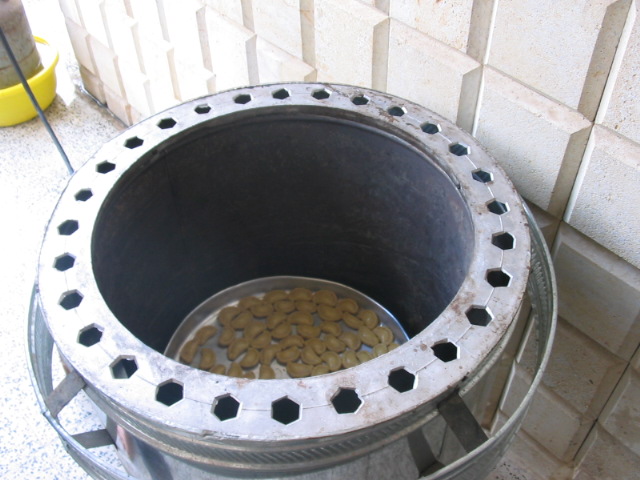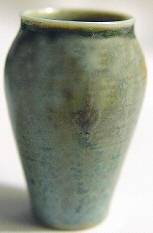Food and Recipes
Najat Habash
Bread Making
Most if not all Bakhdida women excelled in home made bread. Many kinds of bread are made, leavened and unleavened. For the unleavened bread large amounts of wheat flour is sieved first as shown in the picture above then kneaded in to a fine, smooth, and easy to roll dough, Few ladies share the making of the bread; dough is shaped in to small portions.
The first lady (or a little girl is usually given this chore) rolls the portion of dough while sitting around a board made of wood or a more traditional stone board locally known FARSHA using a thick roller GAROMA with a special motion until the dough gets flatter, then it is flipped to the next lady who uses a thin rolling pin locally known GIRA to continue the process of thinning the loaf of bread until it is as thin as the writing paper as shown in the pictures above and below.
The round loaves are collected on a wooden board known TABAK until a good number is collected to be ready for baking. The third lady gets the mud oven ready for baking by using hey and sawdust. The uncooked loaves are slapped on the hot walls of the oven by using special tool known MANZAK; cooked loaves are left flat or folded in to four layers for easier handling and storing. This kind of bread can be stored for about two to three weeks and can be eaten as it is or by sprinkling it with water to soften it.
More sophisticated bread is prepared by brushing oil on the unleavened thin bread and folded it in to many layers to form a thick loaf that is topped with cheese.
Leavened bread is prepared by using mostly dry yeast for fermentation. This kind of bread is thicker and softer than the thin bread, sesame seeds are sprinkled on top of it for flavor and decoration, warm water is used for kneading.
Oil is used while kneading for preparing another kind of leavened bread which is thick and topped with cheese or sesame seeds and brushed with plain yogurt for shining. This kind of bread is very similar to the modern pizza.
A very special treat is prepared by using- GURGUR -or as it is known for the west people-BULGOR-other ingredients are used along with it such as meat, onions, spices and tomato paste.
Meat is excluded for preparing a plain treat from BULGOR used mostly during the fasting season of lent when no meat is used for food.
After the process of bread baking is over, the stew making starts, different kinds of stews are prepared over night in the hot ashes of the mud oven. The ingredients of the stew are washed and kept in a mud pot locally known BOROMTHA. Special long wooden ladle-ARTANEETHA- is used for stirring the stew during the night to prevent it from sticking on the bottom of the pot.
Examples of the stews are;
SHOPATEE: brown lentil with meat, salt and water
HARISA: pearled wheat, meat, oil, salt and water
SHORBA: chick pea, meat, onions, water and salt
All Bakhdida people used mud ovens for baking their own daily bread but nowadays iron ovens are most commonly used.

Food Preservation

Before refrigeration and freezing technologies people of Bakhdida used many ways
to preserve their food stuff.
Most common procedure was DRYING vegetables for example okra was selected first
then threaded and hanged in the direct sun to get rid of the moisture. After it
is completely dry the vegetable is kept in a cool dry place.
Wild plants were dried too; most commonly chamomile which is used as a
traditional remedy for cold. The flowers are plucked in Spring when they are in
full bloom, then spread on a cloth in a single layer that is laid on the floor
in the direct sun. The dried flowers are then packaged and stored in a cool dry
place.
SALTING is another well known way of preserving food. The left over of
sacrificed meat during Xmas is usually preserved in this way for few months. The
meat is cut in to big chunks and alternately layered with big amount of salt in
a stoneware crock locally known-SINDANA-as shown in the picture above. The preserved meat is known as-PISRA
KWESHA- which has a very distinctive smell and flavor, no salt is needed while cooking
it.
Cheese is usually bought in huge chunks before preservation. People would slice
it, melt it in hot water and then shape it in to small portions. These small
portions are salted and cooled down then arranged in a stone
vessel-SINDANA-filled with brine (salty water) and used for the months to come.
EVAPORATION is another way of preserving food. It is the most common way for
preserving tomato paste which is largely used in Bakhdida recipes. Big, fleshy
and fully ripened tomatoes are selected, sliced, salted and left for a while.
Ladies of the house start to squeeze out the tomato juice with their bare hands
and discard the seeds and the peels. The juice is then transferred to huge
shallow tubs and exposed to direct sunlight to thicken, Stirring is done
frequently. The thickened paste is packaged in glass containers for later use.
Another way of preservation is PICKLING. The most common fruit that is pickled
in big amounts is olive. Most families of Bakhdida have olive trees in their
home gardens. Vegetables are used too like turnip, beetroot and many others.
Local wild plants are collected in Spring and pickled like mustard commonly
known-KHAREDLA- which is the most delecious. Red wine vinegar is used along with
salted water for this process, spices are added for enhancement.